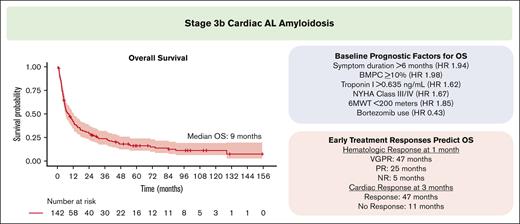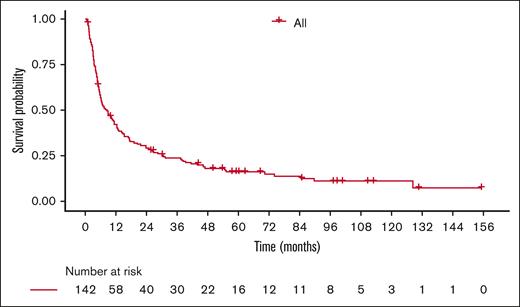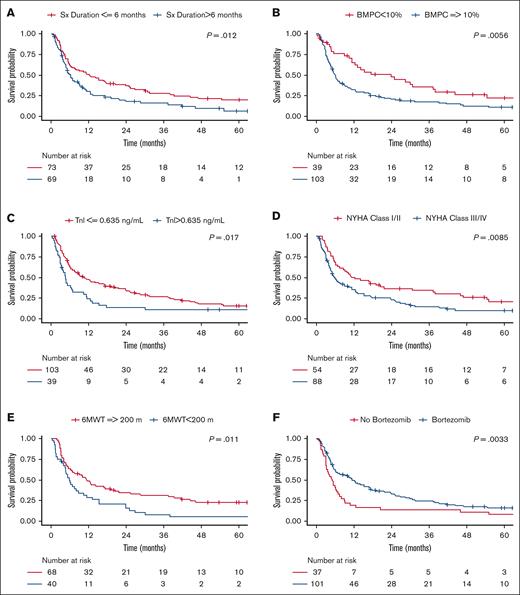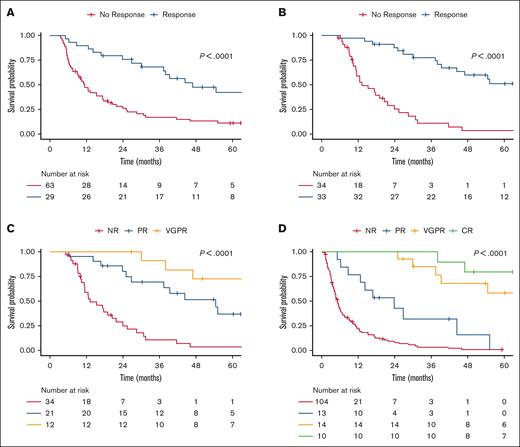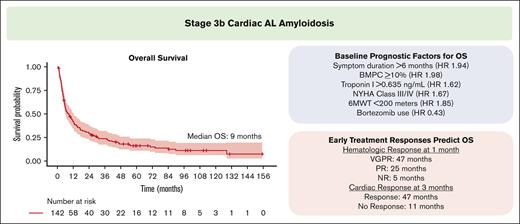Key Points
We identified baseline factors predictive of treatment outcomes and prognostic for survival in stage IIIb AL amyloidosis.
Early hematologic and cardiac responses during treatment predict longer survival in stage IIIb AL amyloidosis.
Abstract
Patients with advanced cardiac immunoglobulin light chain (AL) amyloidosis have a poor prognosis. Early hematologic and cardiac responses can prolong survival, but predictors of these outcomes have yet to be clarified. We report on 142 patients with newly diagnosed stage IIIb AL amyloidosis. After a median follow-up of 60 months, the median overall survival (OS) was 9 months. Independent baseline factors associated with shorter OS were symptom onset to diagnosis >6 months (hazard ratio [HR], 1.94; P = .003); bone marrow plasmacytosis ≥ 10% (HR, 1.98; P = .01); troponin I > 0.635 ng/mL (HR, 1.62; P = .04); New York Heart Association class III or IV (HR, 1.67; P = .04); and 6-minute walk test distance < 200 m (HR, 1.85; P = .01). Early hematologic (within 1 month) and cardiac (within 3 months) responses were significantly associated with longer survival. In a 1-month landmark analysis, patients with a hematologic very good partial response, partial response, and no response had a median OS of 47, 25, and 5 months, respectively (P < .0001). Patients with cardiac response at 3 months had significantly longer OS (47 vs 11 months; P < .0001). On multivariable modeling, bortezomib use was associated with early hematologic and cardiac responses and longer OS. Symptom onset to diagnosis duration of >6 months and difference between the involved and uninvolved free light chain > 350 mg/L were independently associated with lower odds of an early cardiac response. This study identified factors predictive of treatment outcomes and survival in advanced cardiac AL amyloidosis.
Introduction
Immunoglobulin light chain (AL) amyloidosis is a plasma cell dyscrasia, which overproduces misfolded light chains (LCs) that deposit in tissues as amyloid fibrils and cause progressive organ dysfunction. Approximately 70% to 80% of patients with AL amyloidosis experience an amyloid-related cardiomyopathy, and cardiac involvement is the primary determinant of prognosis.1 Mechanistically, amyloidogenic LCs induce cardiac dysfunction via both architectural damage from amyloid fibril deposition as well as direct proteotoxicity.2,3 The severity of cardiac involvement is defined by widely used staging systems that use cardiac biomarkers (N-terminal probrain natriuretic peptide [NT-proBNP], brain natriuretic peptide [BNP], and cardiac troponin I [TnI] or troponin T).4-6 Patients with stage IIIb AL amyloidosis according to the modified Mayo 2004 and Boston University staging systems (NT-proBNP > 8500 pg/mL or BNP > 700 pg/mL and TnI > 0.1 ng/mL) are a particularly high-risk group, with high rates of early death and a poor prognosis (historical median overall survival [OS], 4-6 months).7-10 Despite therapeutic advances in AL amyloidosis, survival outcomes for stage IIIb disease remain largely unchanged and represent an important unmet medical need.11,12
Rapid and deep hematologic responses to treatment are associated with organ responses and survival in AL amyloidosis.13 Such hematologic responses are especially critical in stage IIIb AL amyloidosis for any possibility of prolonged survival. The group at the UK National Amyloidosis Centre (NAC) demonstrated that patients with stage IIIb disease who attained a hematologic very good partial response (VGPR) or complete response (CR) within 30 days of treatment initiation had a median OS of 38 months, as compared with only 7 and 2.6 months for those with a hematologic partial response (PR) or no response (NR), respectively.8 The Pavia group validated these findings and showed that early cardiac responses (within 90 days) are not only possible in stage IIIb disease but also confer a considerable survival benefit (median OS, 54 months).9 Assessment of a composite hematologic and cardiac response (CHCR) may also be helpful in this setting.9,14 Although these previous studies demonstrated the survival benefit of achieving a rapid treatment response, there are limited data regarding baseline factors that predict treatment and survival outcomes in patients with stage IIIb AL amyloidosis. Moreover, the optimal management for this subgroup of patients is not well defined because they have been excluded in most prospective clinical trials to date.
In this study, we describe the treatment and survival outcomes of a large cohort of patients with stage IIIb AL amyloidosis, most of whom received upfront treatment with a bortezomib- or daratumumab-containing regimen. We sought to identify baseline factors predictive of early treatment response attainment and prognostic for survival in this high-risk patient population.
Methods
Study design and patient selection
We searched our institutional prospectively maintained database for patients with newly diagnosed stage IIIb AL amyloidosis at the Amyloidosis Center at the Boston University Chobanian and Avedisian School of Medicine and Boston Medical Center between 2007 and 2022. All patients provided written informed consent for the use of clinical data for research purposes with the approval of the institutional review board and in accordance with the Declaration of Helsinki.
Patients had clinicopathological evidence of AL amyloidosis, with evidence of a plasma cell dyscrasia and positive Congo red staining of a tissue specimen. Accurate typing of the amyloidogenic protein was performed with immunohistochemistry, immunogold electron microscopy, or liquid chromatography and tandem mass spectrometry. Stage IIIb AL amyloidosis was defined according to the Mayo 2004 staging system with the European 2012 modification or the corresponding BNP-based Boston University staging system.4,6,7 All patients had a BNP > 700 pg/mL and TnI > 0.1 ng/mL at the time of diagnosis.6 NT-proBNP levels were available after the assay was adopted at our institution in a subset of patients (n = 48), all of whom had an NT-proBNP > 8500 pg/mL.7 An expert cardiologist evaluated all patients, reviewed the echocardiogram, and confirmed the presence of stage IIIb AL amyloidosis based on cardiac biomarkers.
Patient medical records were reviewed to collect pertinent data, including clinical presentation, laboratories, pathology, echocardiographic and electrocardiographic findings, and functional status assessments. Missing data had a random distribution, and rates were as follows: 6-minute walk test (6MWT; n = 34; 24%); left ventricular (LV) internal diameter end diastole (n = 5; 4%); LV internal diameter end systole (n = 9; 6%); LV posterior wall end diastole (n = 5; 4%); graded diastolic dysfunction (n = 17; 12%); LV mass (n = 7; 5%); LV mass index g/m2 (n = 20, 14%); and LV mass index g/m (n = 21, 15%). The choice of treatment regimen, including glucocorticoid dose, was at the discretion of the individual treating clinician and agent availability.
Response and outcome definitions
Graded hematologic responses were assessed according to consensus criteria from the International Society of Amyloidosis.15 Hematologic CR was defined as the absence of a monoclonal protein by both serum and urine immunofixation electrophoresis as well as a normal free light chain (FLC) ratio or the uninvolved FLC concentration greater than involved FLC concentration regardless of FLC ratio.16 Hematologic VGPR was defined as a difference between the involved and uninvolved FLC (dFLC) < 40 mg/L, and a hematologic PR was defined as a decrease in dFLC of >50% among patients with a baseline dFLC ≥ 50 mg/L. We applied criteria for low-dFLC PR (dFLC < 10 mg/L) for patients with a baseline dFLC between 20 and 49 mg/L.17 Patients with a baseline dFLC < 20 mg/L were considered to have a hematologic response only if the criteria for a CR were met.
Graded cardiac responses were assessed based on changes in BNP or NT-proBNP levels using previously validated cardiac response criteria.18 Cardiac CR was defined as a nadir BNP ≤ 80 pg/mL or NT-proBNP ≤ 350 pg/mL. Cardiac VGPR, PR, and NR were defined as reductions in BNP/NT-proBNP from baseline level of >60%, 30% to 60%, and <30%, respectively. The validated CHCR was also evaluated.14 The CHCR was calculated by combing scores of 0 to 3 for hematologic response (0, CR; 1, VGPR; 2, PR; and 3, NR) and from 0 to 1 for cardiac response (0, cardiac response and 1, no cardiac response).9 OS was defined as the time between diagnosis of AL amyloidosis and death from any cause or last follow-up (censored).
Statistical considerations
Baseline patient characteristics were presented with descriptive statistics. We assessed all treatment outcomes on an intention-to-treat basis. Categorical variables were compared using the χ2 or Fisher exact tests, depending on the number of observations. Receiver operating characteristic analyses were generated based on death at 3 months, and Youden index was used to identify optimal cutoffs to dichotomize continuous variables. Univariable and multivariable logistic regression models were fitted to identify predictors of hematologic and cardiac responses; the outcome measure was odds ratio (OR) with 95% confidence interval (CI). The Kaplan-Meier method was used to calculate time-to-event outcomes, and comparisons were made with the log-rank test. Univariable and multivariable Cox proportional hazard regression models were calculated to identify predictors of OS; the outcome measure was hazard ratio (HR) with 95% CI. Only factors with P < .05 on univariable analysis were included in multivariable models. Patients who underwent an orthotopic heart transplant (OHT) had survival censored at the date of the transplant for predictive modeling. To address potential bias associated with missing data, multiple imputation analyses for logistic and Cox proportional hazard regression models were performed after generating 10 imputed data sets using the chain equations methods; the findings were not altered by the multiple imputation analyses. To account for immortal time bias, landmark analyses were performed to assess the impact of hematologic and cardiac responses on survival. P values <.05 were considered statistically significant. All calculations were obtained using the R software (R Foundation for Statistical Computing, Vienna, Austria).
Results
Patient characteristics
A total of 142 patients with stage IIIb AL amyloidosis were included. Baseline patient characteristics are shown in Table 1. The frontline treatment regimen contained bortezomib in 101 patients (71%), which included bortezomib and dexamethasone (Bor/Dex; 30%); cyclophosphamide, bortezomib, and dexamethasone (CyBorD; 38%); daratumumab with CyBorD (Dara-CyBorD; 3%); and Dara/Bor/Dex (1%). Patients who received bortezomib were more likely to have a lambda LC (77% vs 52%; P = .03), serum albumin < 3.6 g/dL (83% vs 66%; P = .03), and urine protein excretion > 115 mg per 24 hours (79% vs 56%; P = .02). There were no other differences in baseline characteristics for patients who did and did not receive bortezomib (P > .05 for all comparisons).
Treatment responses
Treatment responses on an intention-to-treat basis are summarized in Table 2. Nineteen patients (13%) died before the first response assessment at 1 month and were considered nonresponders. Hematologic response rates at 1, 3, and 6 months after treatment initiation were 44%, 51%, and 52%, respectively. Univariable and multivariable logistic regression models for a hematologic response at 1 month are shown in supplemental Table 1. In the multivariable analysis, the use of bortezomib (50% vs 17%; OR, 4.54; 95% CI, 1.80-13.2; P = .003) was independently associated with higher odds of a hematologic response at 1 month.
Cardiac response rates at 1, 3, and 6 months after treatment initiation were 2%, 20%, and 26%, respectively. Univariable and multivariable logistic regression models for a cardiac response at 3 months are shown in supplemental Table 2. In the multivariable analysis, a cardiopulmonary symptom duration >6 months (12% vs 29%; OR, 0.27; 95% CI, 0.09-0.71; P = .01) and dFLC > 350 mg/L (7% vs 28%; OR, 0.21; 95% CI, 0.04-0.79; P = .03) were independently associated with lower odds of a cardiac response at 3 months, whereas bortezomib use (25% vs 6%; OR, 5.11; 95% CI, 1.28-34.5; P = .04) was independently associated with higher odds. All patients with a cardiac response at 3 months had previously attained a hematologic response at 1 month. The depth of hematologic response at 1 month was associated with cardiac response rates at 3 months (hematologic NR, 1%; PR, 40%; VGPR, 55%; P < .001).
The proportion of patients with a CHCR score of 0 to 2 at 3 and 6 months were 36% and 38%, respectively. Univariable and multivariable logistic regression models for a CHCR score of 0 to 2 at 3 months are shown in supplemental Table 3. In the multivariable analysis, a baseline dFLC > 350 mg/L (17% vs 48%; OR, 0.21; 95% CI, 0.08-0.48; P < .001) was independently associated with lower odds of a CHCR score of 0 to 2 at 3 months, whereas bortezomib use (43% vs 14%; OR, 4.81; 95% CI, 1.79-15.4; P = .004) was independently associated with higher odds.
Treatment responses stratified by the commonly used treatment regimens are shown in supplemental Table 4. The use of bortezomib- and daratumumab-based regimens was associated with significantly better hematologic and cardiac responses and CHCR scores than those with melphalan and dexamethasone.
Survival outcomes
The median follow-up time was 8 months (95% CI, 6-11) for all patients and 60 months (95% CI, 50-99) for surviving patients. At data cutoff, 120 patients (85%) had died, and the median OS of the entire cohort was 9 months (95% CI, 6-13). OS estimates at 3, 6, 12, and 60 months were 82%, 57%, 42%, and 16%, respectively (Figure 1).
OS in stage IIIb AL amyloidosis. Kaplan-Meier survival curve for all patients.
The prognostic factors for OS identified by univariable and multivariable hazard regression analyses are shown in Table 3. In the multivariable model, cardiopulmonary symptom duration, bone marrow plasmacytosis (BMPC), TnI, New York Heart Association (NYHA) class, 6MWT distance, and use of bortezomib were independently associated with OS. A shorter median OS was observed among patients with a cardiopulmonary symptom duration >6 months (6 vs 12 months), BMPC ≥ 10% (6 vs 24 months), TnI > 0.635 ng/mL (5 vs 10 months), NYHA class III or IV (6 vs 12 months), and 6MWT < 200 m (6 vs 11 months), whereas a longer median OS was observed among patients who received bortezomib-based therapy (11 vs 5 months; Figure 2). The median OS for patients who received melphalan and dexamethasone, Bor/Dex, CyBorD, and daratumumab were 4, 7, 12 months, and not reached, respectively (P = .0002; supplemental Figure 1). Survival outcomes for patients (n = 5) who received high-dose melphalan and stem cell transplantation are shown in supplemental Table 5.
Prognostic factors for survival in stage IIIb AL amyloidosis. Kaplan-Meier survival curves stratified based on cardiopulmonary symptom duration (A), BMPC (B), TnI (C), NYHA class (D), 6MWT distance (E), and bortezomib use (F). Sx duration, cardiopulmonary symptom duration. Sx, symptom.
Prognostic factors for survival in stage IIIb AL amyloidosis. Kaplan-Meier survival curves stratified based on cardiopulmonary symptom duration (A), BMPC (B), TnI (C), NYHA class (D), 6MWT distance (E), and bortezomib use (F). Sx duration, cardiopulmonary symptom duration. Sx, symptom.
The presence and depth of hematologic response were significantly associated with OS. In the 1-month landmark analysis, patients with a hematologic response had a significantly longer median OS (30 vs 5 months; P < .0001; Figure 3A). Patients with a hematologic VGPR, PR, and NR at 1 month had a median OS of 47, 25, and 5 months, respectively (P < .0001; Figure 3B). After adjusting for cardiopulmonary symptom duration, BMPC, TnI, NYHA class, 6MWT, and bortezomib use, achieving a hematologic response by 1 month remained associated with significantly longer OS (HR, 0.28; 95% CI, 0.16-0.47; P < .0001). Survival curves stratified by depth of hematologic response at the 3-month landmark and best response are shown in Figure 3C and D, respectively. In the 1-, 3-, and 6-month landmark analyses, bortezomib use was no longer associated with OS after adjusting for attainment of a hematologic response at those time points (P > .05 for all comparisons).
Impact of hematologic responses on survival in stage IIIb AL amyloidosis. Kaplan-Meier survival curves according to categorical hematologic responses at 1-month landmark: VGPR, 47 months; PR, 25 months; NR, 5 months (A-B), 3-month landmark: CR, 55 months; VGPR, 37 months; PR, 15 months; NR, 8 months (C), and best response: CR, 85 months; VGPR, 22 months; PR, 11 months; NR, 4 months (D).
Impact of hematologic responses on survival in stage IIIb AL amyloidosis. Kaplan-Meier survival curves according to categorical hematologic responses at 1-month landmark: VGPR, 47 months; PR, 25 months; NR, 5 months (A-B), 3-month landmark: CR, 55 months; VGPR, 37 months; PR, 15 months; NR, 8 months (C), and best response: CR, 85 months; VGPR, 22 months; PR, 11 months; NR, 4 months (D).
The presence and depth of cardiac response were also significantly associated with OS. In the 3-month landmark analysis, patients with a cardiac response had significantly longer OS (47 vs 11 months; P < .0001; Figure 4A). After adjusting for cardiopulmonary symptom duration, BMPC, TnI, NYHA class, 6MWT, and bortezomib use, achieving a cardiac response at 3 months remained associated with significantly longer OS (HR, 0.44; 95% CI, 0.22-0.87; P = .02). In the 6-month landmark analysis, patients with a cardiac response had significantly longer OS (70 vs 15 months; P < .0001; Figure 4B). Survival curves stratified based on depth of cardiac response at the 6-month landmark and best response are shown in Figure 4C and D, respectively. In the 3- and 6-month landmark analyses, bortezomib use was no longer associated with OS after adjusting for attainment of a cardiac response at those time points (P > .05 for all comparisons).
Impact of cardiac responses on survival in stage IIIb AL amyloidosis. Kaplan-Meier survival curves according to categorical cardiac responses at 3-month landmark (A), 6-month landmark: ≥VGPR, 85 months; PR, 55 months; NR, 15 months (B-C), and best response: CR, not reached; VGPR, 74 months; PR, 24 months; NR, 5 months (D).
Impact of cardiac responses on survival in stage IIIb AL amyloidosis. Kaplan-Meier survival curves according to categorical cardiac responses at 3-month landmark (A), 6-month landmark: ≥VGPR, 85 months; PR, 55 months; NR, 15 months (B-C), and best response: CR, not reached; VGPR, 74 months; PR, 24 months; NR, 5 months (D).
We also evaluated the survival impact of combined hematologic and cardiac responses at 3 and 6 months. In the landmark analyses, patients with a CHCR score from 0 to 2 at 3 months (37 vs 10 months; P < .0001) and 6 months (47 vs 13 months; P < .0001) had significantly longer OS (supplemental Figure 2). Survival curves at the 3- and 6-month landmarks stratified by each possible CHCR score (0-4 points) are shown in supplemental Figure 3.
OHT
Seven patients (5%) received an OHT. Six patients received OHT after chemotherapy (Dara-CyBorD: n = 2; CyBorD: n = 3; and Bor/Dex: n = 1). None of these 6 patients had a cardiac response after chemotherapy despite attaining deep hematologic responses (VGPR, 4 patients; CR, 2 patients) and received OHT for progressive cardiomyopathy (ie, worsening LV ejection fraction and functional capacity). One patient was treated with sequential OHT, followed by high-dose melphalan and stem cell transplantation. After a median follow-up from OHT of 38 months (range, 7-104), 1 patient had died. The median OS after OHT was not reached, and the estimated 5-year OS after OHT was 83%. One patient required salvage therapy for hematologic relapse and received daratumumab monotherapy without evidence of allograft rejection.
Second-line treatment
Twenty-six patients (18%) received a second-line treatment. The median time from the initiation of frontline to second-line treatment was 9 months (95% CI, 5-16). Four patients received a third-line regimen. Among patients who received additional treatment, the regimens used included daratumumab (n = 14; 54%), lenalidomide (n = 7; 27%), melphalan (n = 4; 15%), pomalidomide (n = 2; 8%), ixazomib (n = 1; 5%), and bendamustine (n = 1; 4%). The median OS after initiation of second-line treatment was 8 months (95% CI, 3-29).
Discussion
This study describes the treatment and survival outcomes in 142 patients with stage IIIb AL amyloidosis, a high-risk group historically excluded from prospective clinical trials. A key finding was the poor survival among these patients (median OS, 9 months). This survival estimate compares favorably with those reported by the UK NAC (6 months), Pavia (4.2 months), and Mayo Clinic (4.4 months) groups and may be explained by the increased use of upfront bortezomib- and daratumumab-based regimens in our cohort (74% vs 46%, 48%, and 61%, respectively).8-10 Nevertheless, the prognosis is unsatisfactory and high early mortality persists, with 18% and 43% of patients dying within 3 and 6 months of diagnosis, respectively. Although treatment can induce early hematologic responses, many patients succumb to cardiac complications before organ improvement can occur. As such, OHT remains a potentially life-saving treatment, and our data provide additional evidence that it can be associated with prolonged survival in highly selected patients.19-21
Our data validate that achieving an early and deep hematologic response is a critical treatment goal for patients with stage IIIb AL amyloidosis. We found that patients with a hematologic VGPR at 1 month had a median OS of 47 months; this estimate is in line with previous reports from the UK NAC (38 months) and Pavia (52 months) groups.8,9 Deeper hematologic responses at 1 month also translated into a greater likelihood of early cardiac response. Given these findings, the use of rapidly acting agents (eg, bortezomib and daratumumab) to induce a hematologic response should be prioritized in patients with stage IIIb AL amyloidosis. Our data did not address whether patients without an early hematologic response would benefit from modification of the treatment regimen, but this management approach warrants evaluation.
As previously reported by Basset et al, we observed that early cardiac responses (within 3 months) are possible and confer a significant survival benefit in stage IIIb AL amyloidosis.9 Patients who attained a cardiac response at 3 months had a median OS of ∼4 years. Deeper cardiac responses at both 3- and 6-month landmarks correlated with longer OS, thereby supporting the application of the graded cardiac response criteria in stage IIIb AL amyloidosis.18 We also verified the recently proposed CHCR score,9,14 highlighting that the combined evaluation of hematologic and cardiac responses can enable assessment of early treatment efficacy in patients with stage IIIb AL amyloidosis. In our predictive modeling, a lower baseline dFLC (≤350 mg/L) was associated with higher cardiac and CHCR response rates to treatment. We postulate that perhaps the dFLC level may help identify those patients whose cardiomyopathy is primarily driven by direct LC-induced cardiotoxicity and more responsive to a chemotherapy-induced hematologic response that lowers the concentration of circulating toxic LCs.22,23 In these patients, lower concentrations of cardiotoxic LC may be needed to induce myocardial injury, as opposed to the generation of amyloid fibrils that may require higher LC concentrations and are not readily removed by chemotherapy. Nevertheless, the heterogeneous kinetics of cardiac response attainment highlights the complex pathophysiology underlying cardiac AL amyloidosis.
We identified several baseline adverse prognostic factors for survival in stage IIIb AL amyloidosis. Patients with a BMPC ≥ 10% had shorter OS, which expands upon previous findings correlating a higher BMPC with more advanced cardiac involvement.24 Increased BMPCs may reflect a plasma cell dyscrasia with a higher proliferative capacity that secretes amyloidogenic LC more rapidly and/or less amenable to eradication by chemotherapy. An elevated TnI (>0.635 ng/mL) was particularly associated with adverse survival and may underscore the notion that cardiac troponins are a more sensitive biomarker of myocardial injury than natriuretic peptides, which can be affected by volume status, diuretic use, and renal function. Functional assessments, including NYHA class and 6MWT, were also prognostic of OS and may be a surrogate of cardiopulmonary reserve in patients with stage IIIb disease. This finding expands upon previous studies in AL amyloidosis that showed that the 6MWT distance correlates with the severity of cardiac involvement, NYHA class, and survival.25,26 Interestingly, a prolonged duration between cardiopulmonary symptom onset and AL amyloidosis diagnosis adversely affected survival, highlighting the importance of early diagnosis and prompt treatment initiation on long-term outcomes in AL amyloidosis.27 In contrast to previous studies, the dFLC level did not affect OS, which may be due to differences in study design.8,9 Collectively, these prognostic factors may enable further risk stratification of patients with stage IIIb AL amyloidosis.
Another important observation of this study was the improved treatment and survival outcomes with bortezomib use. This benefit is likely due to the increased likelihood of early and deep responses with bortezomib, as evidenced by the lack of survival benefit in our analysis after adjusting for hematologic and cardiac response attainment. Indeed, rapid hematologic response kinetics with bortezomib in AL amyloidosis has been previously described in prospective clinical trials.28-32 In contrast to our findings, previous retrospective studies did not demonstrate a substantial clinical benefit of bortezomib in patients with stage IIIb AL amyloidosis.8,9,33 However, our results are consistent with what would be expected, based on both the response kinetics described with bortezomib and collective evidence that early hematologic responses confer a survival benefit in stage IIIb AL amyloidosis.8,9 Bortezomib remains a cornerstone in the treatment guidelines for stage IIIb AL amyloidosis.34
The treatment paradigm for AL amyloidosis is rapidly expanding. Dara-CyBorD is currently the standard of care for stage I-IIIa AL amyloidosis based on the ANDROMEDA trial and is also recommended for patients with stage IIIb disease despite them being excluded from ANDROMEDA.34,35 However, it is important to note in the ANDROMEDA trial that patients randomized to the Dara-CyBorD group had a higher incidence of cardiac serious adverse events (SAEs) and that the risk correlated with more advanced cardiac stage (I-IIIa) and NYHA class (I-III).36 Adjusting for the duration of treatment exposure corrected for this observed difference in cardiac SAEs, but the incidence of cardiac SAEs within the first month of treatment remained higher with Dara-CyBorD.36 These cardiac SAEs have been mostly attributed to the underlying amyloid-related cardiomyopathy,36 but increased monitoring for potential cardiotoxicity with Dara-CyBorD in patients with stage IIIb disease seems warranted. This question of cardiotoxicity is being addressed in the ongoing AQUARIUS clinical trial of deferred CyBorD in patients with stage II-IIIa AL amyloidosis (#NCT05250973). A retrospective, multicenter study of Dara-CyBorD in patients with stage IIIb AL amyloidosis (n = 19) was recently published and reported favorable tolerability and efficacy with an estimated 1-year OS of 68%.37 A phase 2 trial of daratumumab monotherapy in stage IIIb AL amyloidosis has also finished accrual, and preliminary results showed that 48% of patients achieved a hematologic response within 1 week, 28% had a cardiac response at 3 months, and the median OS was 9.4 months.38 Beyond plasma cell–targeted therapies, investigative efforts with antiamyloid fibril monoclonal antibodies are ongoing in AL amyloidosis. A recent post hoc analysis of the VITAL study demonstrated a survival benefit of birtamimab in patients with Mayo 2012 stage IV AL amyloidosis,39 and the AFFIRM-AL confirmatory trial of this agent is ongoing (#NCT04973137). Phase 3 evaluation of CAEL-101 is also ongoing in patients with advanced cardiac AL amyloidosis (#NCT04504825), given promising early-phase data.40
Our study is not without the limitations that are inherent in a retrospective study from a referral center. Our analysis may be affected by referral bias because patients had to be healthy enough to travel to our tertiary center for evaluation. In addition, NT-proBNP levels were only available for a subset of patients after our institution adopted the assay. BNP has been validated for staging in AL amyloidosis and may be more specific than NT-proBNP among patients with renal dysfunction.6 Because this was a retrospective study, there were some missing data. To minimize any bias associated with missing data, we performed multiple imputation analyses, which did not alter any of the results or conclusions. Finally, data on global longitudinal strain and cardiac magnetic resonance imaging, which may be important in AL amyloidosis, were not readily available.41,42 Important strengths of this study include the comprehensive list of baseline variables analyzed, use of receiver operating characteristic analysis to identify optimal variable cutoffs, and high rates of novel agent use.
In summary, the findings from our study validated that early hematologic and cardiac responses are associated with prolonged survival in stage IIIb AL amyloidosis. Attainment of a rapid and deep hematologic response is a critical treatment goal. We also identified several baseline factors that are predictive of treatment response and prognostic for survival. Advanced cardiac AL amyloidosis remains an unmet medical need, and prospective clinical trials are urgently needed.
Acknowledgments
The authors thank the current and past members of the Amyloidosis Center, Cancer Clinical Trials Office, Stem Cell Transplant Program, and Center for Cancer and Blood Disorders at the Boston University Chobanian & Avedisian School of Medicine and Boston Medical Center.
This research was supported by the Amyloid Research Fund of the Amyloidosis Center.
Authorship
Contribution: J.N.G. and V.S. designed the study, performed data analysis, and wrote the manuscript; J.N.G., A.S., L.M., and T.J. collected the data; A.S., L.M., T.J., F.L.R., O.K.S., D.M.G., and V.S. performed the research and provided clinical care to the patients; and all authors critically reviewed and approved the manuscript.
Conflict-of-interest disclosure: The authors declare no competing financial interests.
Correspondence: Vaishali Sanchorawala, Amyloidosis Center, Boston University Chobanian & Avedisian School of Medicine, 72 East Concord St, K-503, Boston, MA 02118; e-mail: vaishali.sanchorawala@bmc.org.
References
Author notes
The data sets generated and/or analyzed during this study are available on reasonable request from the corresponding author, Vaishali Sanchorawala (vaishali.sanchorawala@bmc.org).
The full-text version of this article contains a data supplement.

